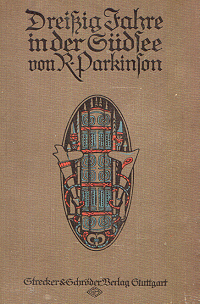
The Pacific Ocean was the arena where pulp writers could use their wildest fantasy to write interesting stories. They populated these great-unknown islands with strange beasts and even stranger people, and no one at that time could prove otherwise. Many of the myths they created were far away from truth, and today we know better. But one man did a thoroughly research with really convincing documentation. His name was R. Parkinson from Germany, who started his work in the end of the 1800-century.
His book is written in the old German language with gothic style, and is based on his work through 30 years of explorations of tribes and new areas. The book is real heavy to read, but when you see all the fantastic photos it will encourage you to read more. It is always interesting to know the background stories for the photos.
Photo: Cover from the incredible book written by the great explorer R. Parkinson
Facts about the book:
- Title: 30 years in the pacific.
- Author: R. Parkinson, who finished his work with this book in 1906.
- Publisher: Dr. B. Ankermann, Royalty Museum Berlin.
- Stuttgart: Strecker & Schrõder Publisher 1911
- Papua New Guinea. Bismarkarchipel-colony
- 56 photos, 4 maps, and 141 photos of handcraft and weapons.
- 30 years of explorations
The book "30 year in the pacific" from the German explorer describes the pacific oceans island as something extraordinary, especially Papua New Guinea and Irian Jaya, and the nearest surrounding islands. This was the place on earth where reality exceeds any traveller's wildest dreams! The way he describes the land and the magnificent nature did apparently a great impression on him. Everywhere he went he could see mountains, swamps and jungles filled with animals and plants unknown to Western science.
All over the tribal people have developed extremely complex and colourful customs; they speak hundreds of distinct languages and some spoken by as few as under thousand people. One of the most disreputable customs was cannibalism.
Today people in the highlands would said that cannibalism or ritual warfare it is not a problem any longer and it has of course been banned by the government. But there are still few places where the government haven't yet reached, and no one can say what cultural practice exists there. Only few Western travellers have reached the remote areas and there are still many places that bear no human footprints at all. This island and the surrounding small islands are surely one of the ultimate destinations for the adventure traveller.
As Parkinson writes about you can find the world's most exotic tribes there. On many of his photos you can see tribes you wouldn't believe existed. The land is described as colourful and astonishing as its fabled bird of paradise. Here is a wild jumble of people with complex tribal liaisons, mutually unintelligible tongues, wild cultural celebrations and ancient agricultural practices. You'll also find rugged mountains, thundering waterfalls, dazzling reef systems and an abundance of exotic birds and beasts.
Some of the last discoveries of human communities were made in here in the 1930's. At the time of first contact, the tribes were living in thriving Stone-Age agricultural communities believing they were the only people on earth. Though some things have changed in the past sixty years, many have not.
After I red Parkinson's detailed research work, I started do wonder: how do the tribes lives today in this country? In what way have their lifestyle been changed due to westernised affection? Do to same tribes live in the same areas as before? I guess much have changed since R. Parkinson and other explorers bushwhacked their way deep in the jungle in the end of the 1800-century. Have some tribes disappeared or are the just forgotten? It is still possible to discover unknown tribes? Are the still tribes deep in the jungle who have had little or no contact with people from the outside? For real explorers I am sure you will find inspirations in this book.
My next planed expedition is to Papua New Guinea and Western Papua (Irian Jaya). It is inspired from our last year's successful travelling on this island. A national newspaper published a 7 pages article about our journey. An old woman in Oslo read about us and then took contact. She had an old book written by the great German explorer R. Parkinson. So thanks to her we borrowed the book for a while. Reading this book, is in my opinion the best source for inspiration you ever can get.
Stein Morten Lund, 29 June 2000
Additional information
Read more about Papua New Guinea and other exciting islands in Pacific on our website.
